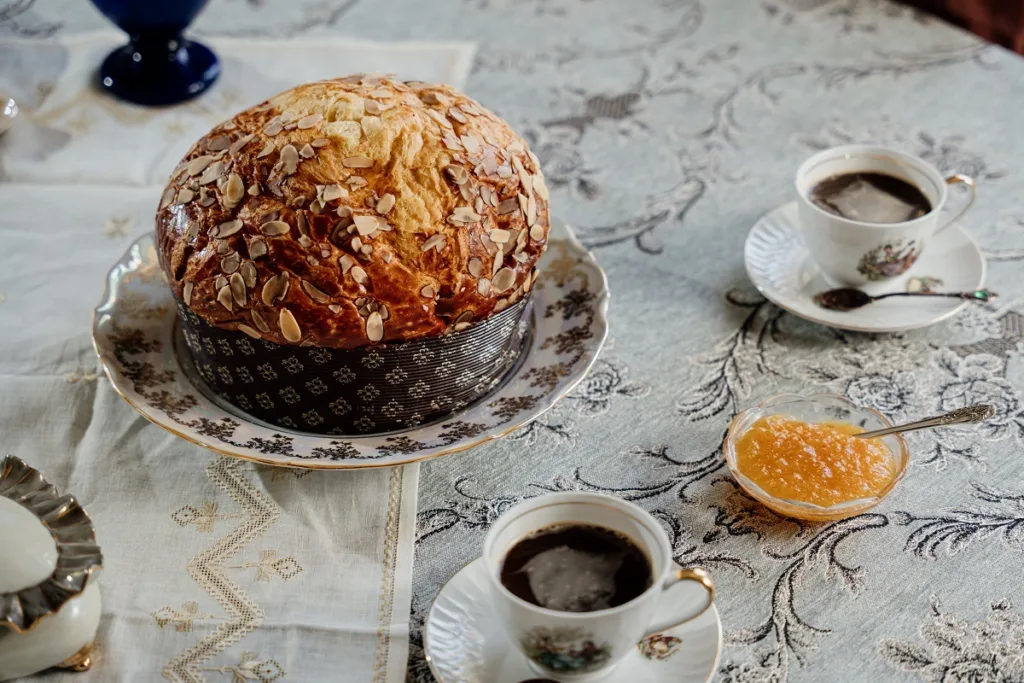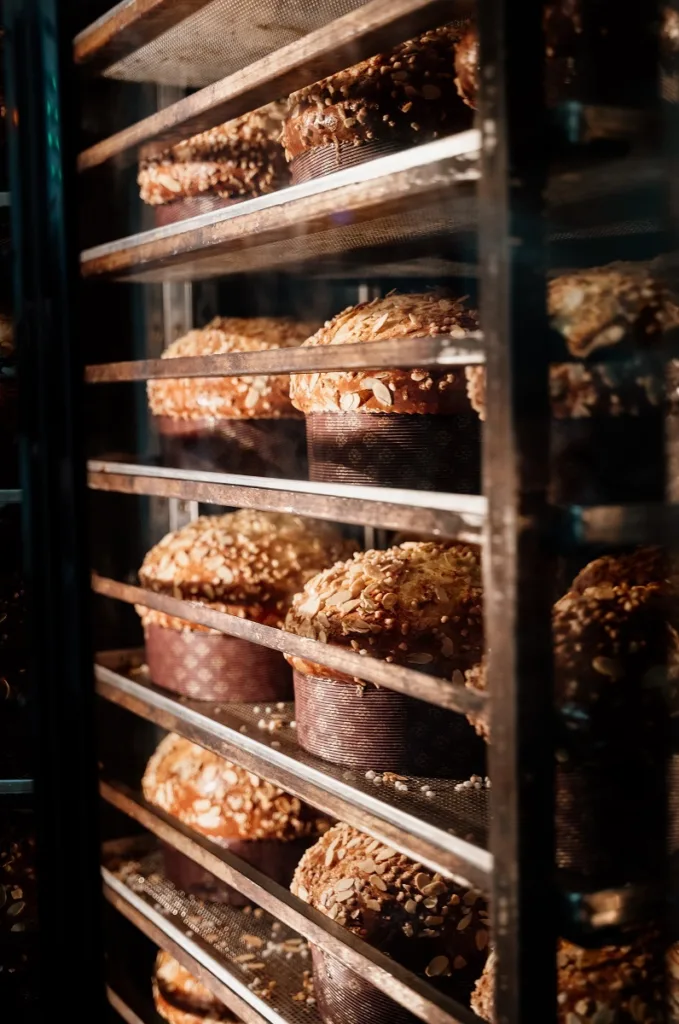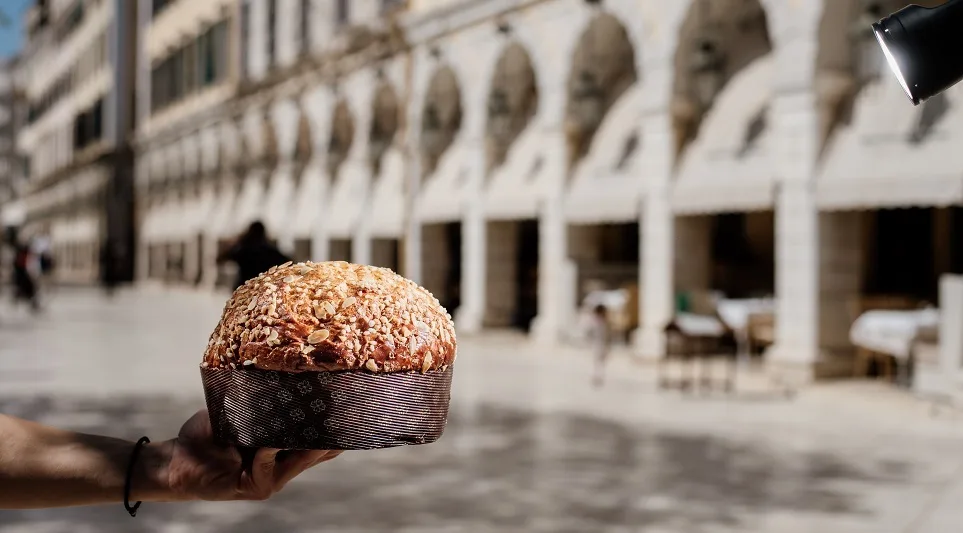Celebrations and sweets always go hand in hand: the unique flavours associated with each important celebration take us with their recipes to traditions lost in time, while with their aromas they awaken memories and increase the impatience for the moment when we will celebrate them.
In our country, Easter takes on the airy, chewy taste of tsourekia, the crisp and fluffy taste of freshly baked koulourakia, the delicious sweetness of chocolate eggs, and the aromas of mastic, mahlab and vanilla mixed with the scent of lilac and blossoming orange trees.
In Corfu, which has established itself as a leading Easter destination, in addition to the spectacular customs, there are added flavours with a long history that cannot be found elsewhere in Greece and transport us directly to Italy. 400-year-old Venetian rule influenced how the Ionian island celebrates Easter, with particular honour given to the fagatsa, a sweet dough reminiscent of tsoureki and panettone.
Although we can find tsoureki and panettone from Italy packaged in some supermarkets, the fogatsa remains unknown and mysterious, but it is also an incredibly delicious sweet, which, for Corfu, is synonymous with Easter.
The birth of a new tradition

To learn the secrets of the addictive, light and hearty taste of fogatsa, we turned to the traditional Korakianitis bakery, at the locals' suggestion, which has been in operation since 1980.
Due to the complex authentic preparation, third-generation bakers specialise in preparing authentic Venetian-influenced fogatsa, making it available in specific quantities all year round.
Valantis Korakianitis, a passionate and measured baker, confesses to us his goal to perfect the recipe he learned from his grandfather and mother to make the Fugassa veneziana, or fugassin as the Venetians call this simple but delicious type of sweet.
Fogatsa started as a poor Easter cake in the 15th century by a baker in Treviso. During Lent, he experimented by enriching the bread he was fermenting with eggs, sugar, and butter. As with other Venetian recipes, the inspiration comes from the East, from Alexandria in particular, where fugassa symbolised the Rebirth and Resurrection of Christ.
The baker's skill had a delicious result, with the soft texture being the main feature.
"However, the cost of the extra ingredients was high, so it was not often prepared," Valantis explains, adding that it gradually became established as a typical Easter dessert, for which even the poorest saved up to enjoy.
We also learn that the fugassa soon became established as a symbol of a marriage proposal. The groom-to-be hid inside it the engagement ring that he would offer his beloved.
Over the centuries,fugassa was enriched with aromatics, reached the tables of the nobles, and established itself in the workshops of the leading confectioners of Venice, who made the original recipe more refined without compromising its simplicity.
The fairy tale has the sweetest ending since the fugassa was loved so much that it established itself as Veneto's most iconic Christmas and Easter dessert. And with the same pride that Milan's top confectioners show off their famous panettone, their Venetian counterparts are just as proud of their fugassa.
A "sweet mess"

Given how similar panettone and fogatsa look, the most reasonable question is how they differ. Valantis is clear: "fogatsa has its own identity and certainly its own history, but there are indeed elements in common."
First of all, for Italians, they are sweets associated with the biggest holidays of the year and accompany happy family gatherings. Also, as we found out in the workshop of the Korakianitis bakery, the last stage of preparation is the same since the fogatsa are also cooled and hanging upside down. However, they do not contain as much butter or orange zest as panettone.
In the neighbouring country, the original fugassa is coated with a special glaze - egg white, almond powder, flour and sugar - while the classic panettone, the famous Panettone Milanese, is plain on its surface, which is simply drawn like a cross and butter is added.
"At least until recently," Valantis explains.
Because modern confectioners now add glaze, panettone moderno looks the same as fugassa veneziana.
"People are now used to panettone with this appearance, and this is also the reason why we do not use its classic glaze in the Corfu fogatsa. So that customers don't think they are buying a type of panettone," Valantis explained to us, thus pointing out the difference between Corfu and Venetian fogatsa.
Simple materials, special technique

The Korakianitis family's workshop is creatively effervescent on the days they make fogatsa. Five of the seven siblings, the third generation of the family, are employed at the bakery, and Valantis has an "almost love affair" with fogatsa.
He talks about their top-tasting creation and is fascinated by how the Italian tradition has been passed down to his island, preserved and continues to this day.
While preparing the ingredients, he tells us about one of the first Corfu confectioners who worked with fogatsa. Now a grandfather and having retired, he had told him how he used yeast from chickpeas, flour which - due to the poor quality of Greek flour after the war - was imported from Canada, eggs, butter and sugar, of course, but also the wooden mastello (wooden bucket) of Venetian origin. 4-5 people were needed to ferment the leaven at the same time, which, after rising and cutting, was taken to a bakery for baking.
As for his own grandfather, the founder of the bakery?
"His recipes are still in our drawers, but it was my mother who, by testing and constantly trying to improve the technique, evolved and brought out the unique taste of fogatsa," Valantis explained.
And the ingredients? Flour exclusively from Italy, the type used in panettone; butter of excellent quality; only egg yolks; vanilla; mastic that gives a Constantinople aroma; brandy; handmade orange paste; and, in addition to sugar, Corfu honey.
The latter, in addition to nourishing the yeast, enriches the dessert with the aromas of Corfu nature, while to our question why kumquat liqueur is not used instead of brandy, the explanation is that the latter is preferred due to stable quality, fidelity to the original recipe and avoiding predominance of the citrus flavour.
As important as the quality of the ingredients is, the preparation technique is just as important. The process takes more than two days.
Fermentation starts with a low percentage of yeast and is transferred for 5-6 hours to a special maturation area so that it swells sufficiently.
On the second day, the dough is cut, portioned into moulds, and carved into a cross—that's why the baked fogatsa seems to have peaks and points—and right there, another piece of fragrant butter is put in to prevent the surface from dehydrating and to continue rising in the oven for another 20'- 25'. Before entering, it is lathered with egg, almond, and sugar, which, in a way, replaces the Venetian glaze.
When we return to the workshop on the second day, the sight of the baked fogatsa's hanging upside down for a whole night so that the surface does not settle due to the high butter content is impressive, but the aroma intoxicates you and makes you yearn to try them.
The taste is addictive, the aromas subtle, and so well suited to the light texture that you are easily seduced into an additional—and yet another—piece. Valantis's effort and dedication to the process are justified.
"When the dough calls you, you must always be present, even if a few minutes of delay are capable of altering the result in taste and texture," he said.
Needless to say, there is no need for preservatives, additives, or improvers. For the young baker, the challenge is to perfect the technique. That's why the shelf life of fogatsa, which reaches ten days, is solely due to the long-term maturation of the dough.
Now, if there is a chance that someone can be so restrained as not to eat the fogatsa in 10 days, that seems rather improbable.
Enjoy all year round.

The Korakianitis fogatsa is so tasty, and the people of Corfu love it so much that the family does not only have it during the Easter season. The tickling aromas of Venetian fogatsa flood the outskirts of the city, where the workshop and main bakery are located, usually once a week, every day of Easter and Christmas.
For Valantis Korakianitis, the oven is his natural environment anyway. There, he grew up watching the details of making very high-quality pastries, which range from amazing sourdough bread to croissants with bougainvillea cream.
What does he do when he's not making fogatsa's? He prepares small batches of ice cream, travels to Italy to meet confectioners and bakers, joins them in Italian workshops, and attends panettone-making seminars in Verbania, north of Milan.
He filters the international trends and approaches he is taught by focusing on how well they combine with local traditions.
"Innovation is good, but we don't touch tradition!" he stressed.
Info: Korakianitis Bakery: 11 Donatou Dimoulitsa, Corfu & Thesi Triklino-Alepou, Corfu
Orders for shipping across Greece: tel. 6975-263490, mail: [email protected]
Arietta Pouliou is a columnist for Cantina. Translated by Paul Antonopoulos.
READ MORE: Antiparos, the perfect Greek island.


